June 19, 2015 at 5:39 am
[caption id="attachment_754" align="alignright" width="500"]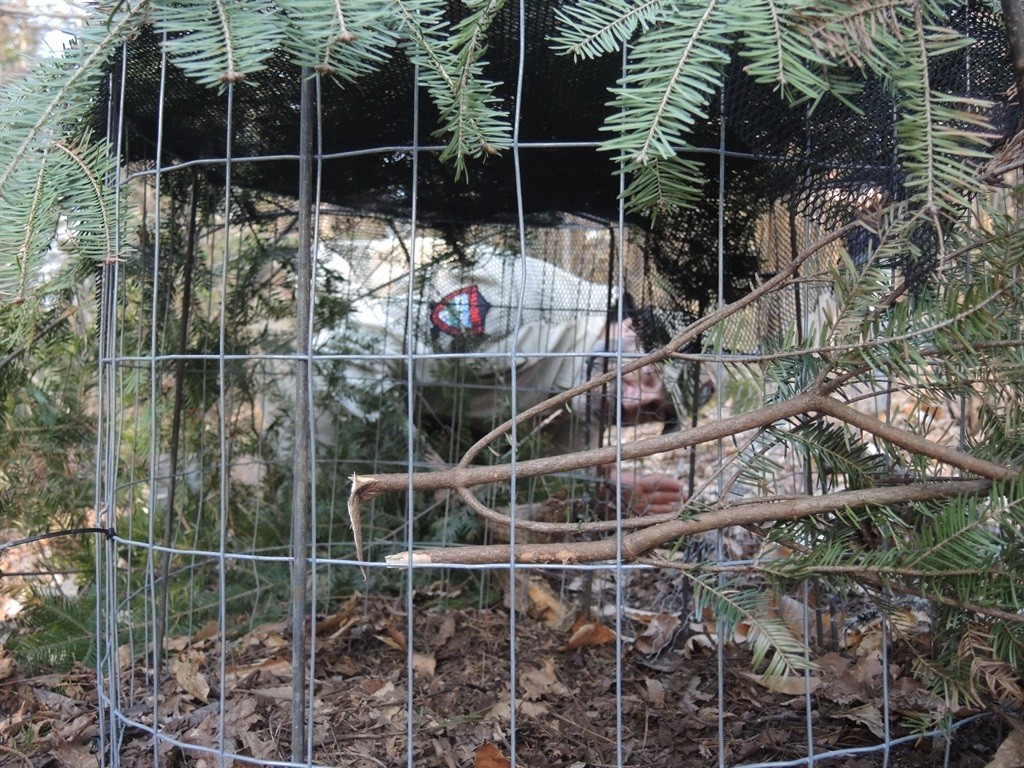 IFW Biologist Kelsey Sullivan peers into the holding area of the trap.[/caption]
IFW wildlife biologists Kelsey Sullivan and Brad Allen, in conjunction with Dr. Erik Blomberg at the University of Maine are overseeing a Ruffed Grouse Telemetry Survey that will provide IFW biologists better data on grouse nesting success and grouse survival.
The study is taking place in two different locations that utilize different forest management practices. One is an area that sees a fair amount of hunting pressure and recreational use, and another area that is an actively managed, privately-owned commercial forest.
Grouse, or partridge, as they are commonly known in Maine, are arguably Maine’s most popular game bird. They are also popular with wildlife watchers as well, as seeing (or hearing) a grouse drumming during mating season is something you won’t soon forget.
Grouse abundance varies year to year, with conditions during nesting season the main factor behind nesting success and grouse numbers. Grouse are ground nesters, laying 8-12 eggs in May each year. Cold, rainy days during the nesting season can have a big impact on success. Once hatched, grouse are also a favored food item for many a predator.
[caption id="attachment_757" align="alignleft" width="225"]
IFW Biologist Kelsey Sullivan peers into the holding area of the trap.[/caption]
IFW wildlife biologists Kelsey Sullivan and Brad Allen, in conjunction with Dr. Erik Blomberg at the University of Maine are overseeing a Ruffed Grouse Telemetry Survey that will provide IFW biologists better data on grouse nesting success and grouse survival.
The study is taking place in two different locations that utilize different forest management practices. One is an area that sees a fair amount of hunting pressure and recreational use, and another area that is an actively managed, privately-owned commercial forest.
Grouse, or partridge, as they are commonly known in Maine, are arguably Maine’s most popular game bird. They are also popular with wildlife watchers as well, as seeing (or hearing) a grouse drumming during mating season is something you won’t soon forget.
Grouse abundance varies year to year, with conditions during nesting season the main factor behind nesting success and grouse numbers. Grouse are ground nesters, laying 8-12 eggs in May each year. Cold, rainy days during the nesting season can have a big impact on success. Once hatched, grouse are also a favored food item for many a predator.
[caption id="attachment_757" align="alignleft" width="225"]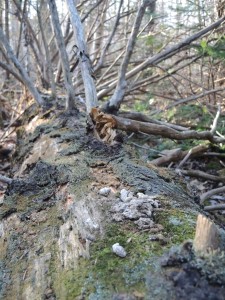 A grouse drumming log, complete with droppings.[/caption]
Until now, most research on grouse has been conducted in the mid-west, or the Appalachian mountain areas of the south. This study will give biologists local data that will allow biologists to better manage grouse populations in the future.
However, in order to get this data, biologists have to capture live grouse first. Last fall, biologists captured and radio tagged 106 grouse.
[caption id="attachment_751" align="alignright" width="300"]
A grouse drumming log, complete with droppings.[/caption]
Until now, most research on grouse has been conducted in the mid-west, or the Appalachian mountain areas of the south. This study will give biologists local data that will allow biologists to better manage grouse populations in the future.
However, in order to get this data, biologists have to capture live grouse first. Last fall, biologists captured and radio tagged 106 grouse.
[caption id="attachment_751" align="alignright" width="300"]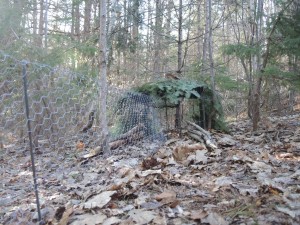 The foot-high chicken wire leads grouse to the covered "catch" area where grouse get in, but don't get out. [/caption]
The key to catching grouse is to build a better grouse trap. Sullivan and crew posts a 50 foot length of foot-high chicken wire on the forest floor, with a semi-circular funnel trap at the end. The funnel is similar in function to that of a lobster trap, where those that go in are unlikely to come back out.
In theory, the grouse bumps into the fence, follows it for its length in an attempt to get around it, only to end up in the funnel trap.
Sullivan and his team set up 17 traps and checked them twice a day this spring. They captured and tagged three grouse before the grouse started nesting. Once the begin nesting, the traps are pulled since they didn’t want a grouse away from their nest for an extended period of time.
[caption id="attachment_753" align="alignleft" width="300"]
The foot-high chicken wire leads grouse to the covered "catch" area where grouse get in, but don't get out. [/caption]
The key to catching grouse is to build a better grouse trap. Sullivan and crew posts a 50 foot length of foot-high chicken wire on the forest floor, with a semi-circular funnel trap at the end. The funnel is similar in function to that of a lobster trap, where those that go in are unlikely to come back out.
In theory, the grouse bumps into the fence, follows it for its length in an attempt to get around it, only to end up in the funnel trap.
Sullivan and his team set up 17 traps and checked them twice a day this spring. They captured and tagged three grouse before the grouse started nesting. Once the begin nesting, the traps are pulled since they didn’t want a grouse away from their nest for an extended period of time.
[caption id="attachment_753" align="alignleft" width="300"]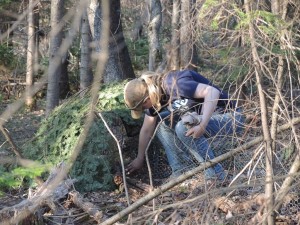 UMaine Grad Student Ellie Mangelinckx clears the grouse trap of some debris in the entrance area.[/caption]
They will be putting the traps up again this August. Last year during the fall, they captured 106 grouse and followed them through the winter.
During the fall and through last year’s harsh winter, over 60% of the radio tagged birds were killed. Some were to hunters (15%), but the vast majority were not. The winter mortality number is a bit higher than what had been shown in other states, but that speaks directly to why it is so important to get local Maine data. The study is expected to continue for at least another two years.
So far this spring, 14 radio-tagged grouse have nested. There have been three total nest failures and two have nested again and re-laid eggs. There have also been a couple nests where the hen was taken by another animal. The first grouse chicks started hatching on June 5.
[caption id="attachment_755" align="alignright" width="300"]
UMaine Grad Student Ellie Mangelinckx clears the grouse trap of some debris in the entrance area.[/caption]
They will be putting the traps up again this August. Last year during the fall, they captured 106 grouse and followed them through the winter.
During the fall and through last year’s harsh winter, over 60% of the radio tagged birds were killed. Some were to hunters (15%), but the vast majority were not. The winter mortality number is a bit higher than what had been shown in other states, but that speaks directly to why it is so important to get local Maine data. The study is expected to continue for at least another two years.
So far this spring, 14 radio-tagged grouse have nested. There have been three total nest failures and two have nested again and re-laid eggs. There have also been a couple nests where the hen was taken by another animal. The first grouse chicks started hatching on June 5.
[caption id="attachment_755" align="alignright" width="300"]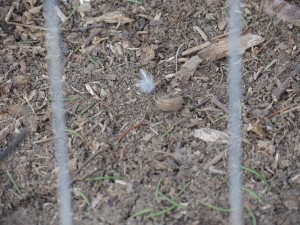 A small downy feather is left behind from a grouse that was captured earlier.[/caption]
Once all the nests hatch, biologists will start to follow the movements of the hen and the brood. This will give biologists a better understanding of just what habitat young grouse prefer, and insight into the types of food they prefer. This information is very useful when it comes to habitat management in the future.
Come August, the grouse traps will be set again, and this fall the plan is to set 75 total traps in each area in order to capture more females.
We’ll keep you updated.
A small downy feather is left behind from a grouse that was captured earlier.[/caption]
Once all the nests hatch, biologists will start to follow the movements of the hen and the brood. This will give biologists a better understanding of just what habitat young grouse prefer, and insight into the types of food they prefer. This information is very useful when it comes to habitat management in the future.
Come August, the grouse traps will be set again, and this fall the plan is to set 75 total traps in each area in order to capture more females.
We’ll keep you updated.
 IFW Biologist Kelsey Sullivan peers into the holding area of the trap.[/caption]
IFW wildlife biologists Kelsey Sullivan and Brad Allen, in conjunction with Dr. Erik Blomberg at the University of Maine are overseeing a Ruffed Grouse Telemetry Survey that will provide IFW biologists better data on grouse nesting success and grouse survival.
The study is taking place in two different locations that utilize different forest management practices. One is an area that sees a fair amount of hunting pressure and recreational use, and another area that is an actively managed, privately-owned commercial forest.
Grouse, or partridge, as they are commonly known in Maine, are arguably Maine’s most popular game bird. They are also popular with wildlife watchers as well, as seeing (or hearing) a grouse drumming during mating season is something you won’t soon forget.
Grouse abundance varies year to year, with conditions during nesting season the main factor behind nesting success and grouse numbers. Grouse are ground nesters, laying 8-12 eggs in May each year. Cold, rainy days during the nesting season can have a big impact on success. Once hatched, grouse are also a favored food item for many a predator.
[caption id="attachment_757" align="alignleft" width="225"]
IFW Biologist Kelsey Sullivan peers into the holding area of the trap.[/caption]
IFW wildlife biologists Kelsey Sullivan and Brad Allen, in conjunction with Dr. Erik Blomberg at the University of Maine are overseeing a Ruffed Grouse Telemetry Survey that will provide IFW biologists better data on grouse nesting success and grouse survival.
The study is taking place in two different locations that utilize different forest management practices. One is an area that sees a fair amount of hunting pressure and recreational use, and another area that is an actively managed, privately-owned commercial forest.
Grouse, or partridge, as they are commonly known in Maine, are arguably Maine’s most popular game bird. They are also popular with wildlife watchers as well, as seeing (or hearing) a grouse drumming during mating season is something you won’t soon forget.
Grouse abundance varies year to year, with conditions during nesting season the main factor behind nesting success and grouse numbers. Grouse are ground nesters, laying 8-12 eggs in May each year. Cold, rainy days during the nesting season can have a big impact on success. Once hatched, grouse are also a favored food item for many a predator.
[caption id="attachment_757" align="alignleft" width="225"] A grouse drumming log, complete with droppings.[/caption]
Until now, most research on grouse has been conducted in the mid-west, or the Appalachian mountain areas of the south. This study will give biologists local data that will allow biologists to better manage grouse populations in the future.
However, in order to get this data, biologists have to capture live grouse first. Last fall, biologists captured and radio tagged 106 grouse.
[caption id="attachment_751" align="alignright" width="300"]
A grouse drumming log, complete with droppings.[/caption]
Until now, most research on grouse has been conducted in the mid-west, or the Appalachian mountain areas of the south. This study will give biologists local data that will allow biologists to better manage grouse populations in the future.
However, in order to get this data, biologists have to capture live grouse first. Last fall, biologists captured and radio tagged 106 grouse.
[caption id="attachment_751" align="alignright" width="300"] The foot-high chicken wire leads grouse to the covered "catch" area where grouse get in, but don't get out. [/caption]
The key to catching grouse is to build a better grouse trap. Sullivan and crew posts a 50 foot length of foot-high chicken wire on the forest floor, with a semi-circular funnel trap at the end. The funnel is similar in function to that of a lobster trap, where those that go in are unlikely to come back out.
In theory, the grouse bumps into the fence, follows it for its length in an attempt to get around it, only to end up in the funnel trap.
Sullivan and his team set up 17 traps and checked them twice a day this spring. They captured and tagged three grouse before the grouse started nesting. Once the begin nesting, the traps are pulled since they didn’t want a grouse away from their nest for an extended period of time.
[caption id="attachment_753" align="alignleft" width="300"]
The foot-high chicken wire leads grouse to the covered "catch" area where grouse get in, but don't get out. [/caption]
The key to catching grouse is to build a better grouse trap. Sullivan and crew posts a 50 foot length of foot-high chicken wire on the forest floor, with a semi-circular funnel trap at the end. The funnel is similar in function to that of a lobster trap, where those that go in are unlikely to come back out.
In theory, the grouse bumps into the fence, follows it for its length in an attempt to get around it, only to end up in the funnel trap.
Sullivan and his team set up 17 traps and checked them twice a day this spring. They captured and tagged three grouse before the grouse started nesting. Once the begin nesting, the traps are pulled since they didn’t want a grouse away from their nest for an extended period of time.
[caption id="attachment_753" align="alignleft" width="300"] UMaine Grad Student Ellie Mangelinckx clears the grouse trap of some debris in the entrance area.[/caption]
They will be putting the traps up again this August. Last year during the fall, they captured 106 grouse and followed them through the winter.
During the fall and through last year’s harsh winter, over 60% of the radio tagged birds were killed. Some were to hunters (15%), but the vast majority were not. The winter mortality number is a bit higher than what had been shown in other states, but that speaks directly to why it is so important to get local Maine data. The study is expected to continue for at least another two years.
So far this spring, 14 radio-tagged grouse have nested. There have been three total nest failures and two have nested again and re-laid eggs. There have also been a couple nests where the hen was taken by another animal. The first grouse chicks started hatching on June 5.
[caption id="attachment_755" align="alignright" width="300"]
UMaine Grad Student Ellie Mangelinckx clears the grouse trap of some debris in the entrance area.[/caption]
They will be putting the traps up again this August. Last year during the fall, they captured 106 grouse and followed them through the winter.
During the fall and through last year’s harsh winter, over 60% of the radio tagged birds were killed. Some were to hunters (15%), but the vast majority were not. The winter mortality number is a bit higher than what had been shown in other states, but that speaks directly to why it is so important to get local Maine data. The study is expected to continue for at least another two years.
So far this spring, 14 radio-tagged grouse have nested. There have been three total nest failures and two have nested again and re-laid eggs. There have also been a couple nests where the hen was taken by another animal. The first grouse chicks started hatching on June 5.
[caption id="attachment_755" align="alignright" width="300"] A small downy feather is left behind from a grouse that was captured earlier.[/caption]
Once all the nests hatch, biologists will start to follow the movements of the hen and the brood. This will give biologists a better understanding of just what habitat young grouse prefer, and insight into the types of food they prefer. This information is very useful when it comes to habitat management in the future.
Come August, the grouse traps will be set again, and this fall the plan is to set 75 total traps in each area in order to capture more females.
We’ll keep you updated.
A small downy feather is left behind from a grouse that was captured earlier.[/caption]
Once all the nests hatch, biologists will start to follow the movements of the hen and the brood. This will give biologists a better understanding of just what habitat young grouse prefer, and insight into the types of food they prefer. This information is very useful when it comes to habitat management in the future.
Come August, the grouse traps will be set again, and this fall the plan is to set 75 total traps in each area in order to capture more females.
We’ll keep you updated.